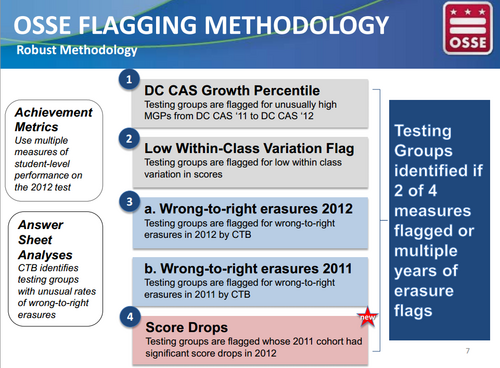For all we know, cheating is even more widespread

Photo by opensourceway on Flickr.
This is one half of a point-counterpoint about recent revelations over cheating on DC standardized tests at DCPS and charter schools. read the other view, by Natalie Wexler.
The DC state agency entrusted to protect struggling DC schoolchildren from having their tests altered went to great lengths to cover up potential widespread cheating last Friday. Cheating could also be more pervasive than we know, because it refused to investigate more widely.
Dumping bad news on a Friday afternoon is the oldest PR trick in the book. It shows an inappropriate concern by the Office of the State Superintendent of Education (OSSE) to hide bad news about the schools under its purview. When Georgia announced its audit of cheating in Atlanta schools, it did so on a Tuesday.
However, what is most concerning is the patently false claim, quickly repeated by DC Public Schools and the Public Charter School Board, that the audit “serves as proof that 99.4% [of classrooms] are following the rules.”
DC agency refuses to broaden investigation
The audit proceeded in two stages. First, OSSE flagged 41 classrooms for independent investigation. Second, an outside investigator analyzed wrong-to-right erasures and interviewed students and teachers.
Of the 41 classrooms investigated, 18 were found to have cheated. Of the 10 DCPS schools that the auditor investigated for cheating, 7 were found to have cheated.
DCPS responded to this news with the incredulous claim that “nearly all of our teachers, more than 99 percent, are following the very strict procedures and protocols we have in place to prevent testing impropriety.”
I asked Chancellor Kaya Henderson on Twitter, “Out of concern for students, isn’t it most prudent to progressively widen [the] flagging method until no cheating [classrooms are] found?” Henderson replied, “I don’t make the rules, but maybe you should share your thoughts with those who do?”
If such a large portion of flagged classrooms were found to have cheated, the obvious question is whether OSSE should broaden the number of schools flagged for investigation.
I talked to OSSE’s Director of Data Management, Jeff Noel, this morning and he explained the method for flagging which classrooms to investigate.
There are four measures used to identify suspected classrooms for investigation. Classrooms that show up on two of these four measures are flagged for investigation.
OSSE could investigate schools that trigger even one of these measures. The first two measures use a 10% threshold to determine “unusually high” test scores or “low” in-class score variation. OSSE could expand this threshold to 12% or 15% and see if subsequent investigation continued to reveal cheating classrooms.
Noel didn’t deny that OSSE could do these things, but explained that he was only in charge of the flagging method step, despite being OSSE’s chief statistician. Assistant Superintendent of Education Kayleen Irizarry is in charge of the entire method for determining how many classrooms cheated.
Exposing cheating classrooms matters
When cheating happens that OSSE doesn’t disclose, schoolchildren are the real victims.
- Struggling students don’t get the support they need: Principals receive detailed test results and allocate resources accordingly. When teachers cover up the challenges faced by their students, struggling students are less likely to get the help they need.
- Test security is less likely improve: When the Department of Education administers its tests (which are different from the OSSE-administered tests) federal employees oversee all testing and teachers never touch the tests. That’s expensive. It’s unlikely that OSSE will go to such lengths in administering its tests, and that the Council would fund it, as long as OSSE believes that 99.4% of classrooms are not cheating.
- Teachers who don’t cheat are unfairly evaluated: DC Public Schools teacher evaluations use a “value-added” metric that compares the growth of their students from previous years to the growth of similar students in other teachers’ classes. When a teacher cheats, it raises the baseline for the teacher who gets those students the next year. That means that teacher will have a much harder time gaining a good IMPACT score.
OSSE should continue its investigation immediately in the interest of struggling schoolchildren and honest teachers. It should broaden its flagging method iteratively until it stops finding any more classrooms that have cheated. Maybe it won’t find any more, but it’s not fair to assume that nobody else has cheated until OSSE looks more carefully.

